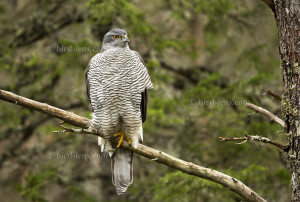 ….no birds and no squirrels to hear around. Snow is falling. The table for the Goshawk (Accipiter gentilis) finally is beautifully covered with snow. This gives great pictures from the Northern Goshawk – if he is coming. After a while, the first Chicadees are to be seen. First Blue Tits (Cyanistes caeruleus) and Great Tits (Parus major) and finally the rest of the bunch: Willow Tits (Poecile montanus), Coal Tits (Periparus ater) and Crested Tit (Lophophanes cristatus). All can be observed around the feeders filled to the top with grain. A little later, the first Eurasian Jay (Garrulus glandarius) arrives. At some time in the morning, there a intensively calling Eurasian Jays is to be heard. Is there about the Goshawk? Maybe just sitting in the neighborhood on a branch? Waiting for a secure situation to feed? Nothing to see. It’s almost midday and I’m already a bit discouraged. I am sitting here for more than 6 hours and I still have not triggered a single shot.
….no birds and no squirrels to hear around. Snow is falling. The table for the Goshawk (Accipiter gentilis) finally is beautifully covered with snow. This gives great pictures from the Northern Goshawk – if he is coming. After a while, the first Chicadees are to be seen. First Blue Tits (Cyanistes caeruleus) and Great Tits (Parus major) and finally the rest of the bunch: Willow Tits (Poecile montanus), Coal Tits (Periparus ater) and Crested Tit (Lophophanes cristatus). All can be observed around the feeders filled to the top with grain. A little later, the first Eurasian Jay (Garrulus glandarius) arrives. At some time in the morning, there a intensively calling Eurasian Jays is to be heard. Is there about the Goshawk? Maybe just sitting in the neighborhood on a branch? Waiting for a secure situation to feed? Nothing to see. It’s almost midday and I’m already a bit discouraged. I am sitting here for more than 6 hours and I still have not triggered a single shot.
Me and my group entered the hide in the depths of these Norwegian wintry woods before 6:00 am. On the way to the hide, our path was illuminated only by our meagre headlamps, the air in front misted by our collective breaths. The snoots of the hide were prepped with lenses, cameras were mounted, and attached. A dead Willow Ptarmigan was laid out on the table as a bait. The scenery looks like a forest floor, with snow contrasting with the depths of surrounding pines. Our guide lighted the table with the bait that our cameras find the table and focus on it. That in preparation of the fact we could not move our lenses too much once our target bird arrived.
For 6 hours, the camera was not moved. I even unwrapped and chewed my sandwich carefully not to produce too much noise with my teeth. The Ghost I wanted to photograph is a shy creature. Something strange, say movement, noise, change in surrounding; all discourage this otherwise regular visitor from the daily bait. The lenses are locked in position. Anything we might want from our bags is readily available to reduce noise. The two cameras are set to single Silent Mode. If a Goshawk comes, it is because you as a photographer pay patience.
Suddenly a bird sits on a branch over the table. We did not see, how and when it came. Really a Ghost!
She is a female of a Northern Goshawk. Fancy. She carefully looks down and examines the forest floor and the bait on the table. OK, we wait and let the Goshawk feed and then we take single shots on the quietest mode we have. I will start with Silent Mode of my Canon EOS 5 D Mark III. She hops down the on the mossy table with the Ptarmigan. Immediately she starts to feed. The Goshawk female swallows the first bite and I know I do not to hurry. We watch amazed that this bird is so close to us and let us participate in watching feeding. After a while we press the shutter of our cameras. Focus and squeeze. One shot. The Goshawk is initially a little nervous on the bait, plucks a little at the slut, looking around. The environment seems to be secure. She turn out to be not nervous anymore. We cannot hurry.
This bird is so stunning. We shoot a myriad of shots to the Goshawk. Eventually changing to “Normale” Mode later even in HighSpeed-Mode. The Ptarmigan is frozen, so even the powerful female of a Northern Goshawk has to handle the bait for a while. Finally she shiffers its feathers, turns to the observers as to say: That´s it!
Than a flash of the wings and it is gone, with just some white feathers and blood left on the table.
The same or another Goshawk does not appear for the rest of the day. Now it is dark. And it is time to leave. I have the images I wanted: What a day!
To meet the growing demand for top shots of the rarer species of birds of the Palearctic, Bird-lens.com made trips to areas such as the Brandenburg lakes, Lake Neusiedl but also taken to remote locations such as the coastal rain forests in Central Norway. This to do anything to shoot excellent photos of the Birds of the Western Palearctic. The results of images from rare Western Palaearctic birds are very good. The beautiful images that you see in the gallery, are just a first impression of what you’ll find behind the tab “Picture- Shop” very soon. Just give bird-lens.com a message, if you need a picture of a bird before new pictures are online.